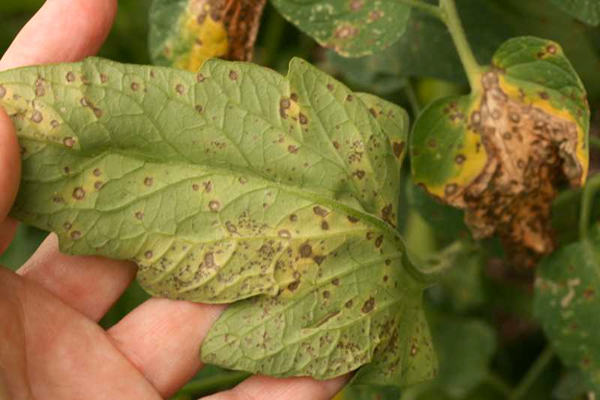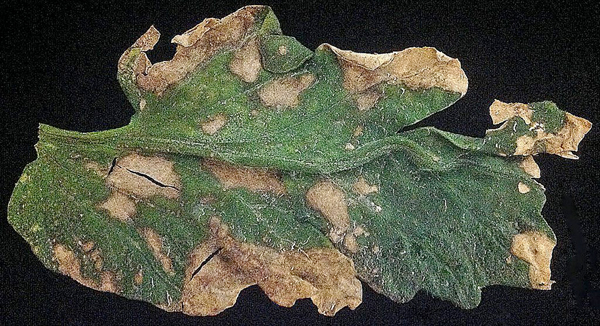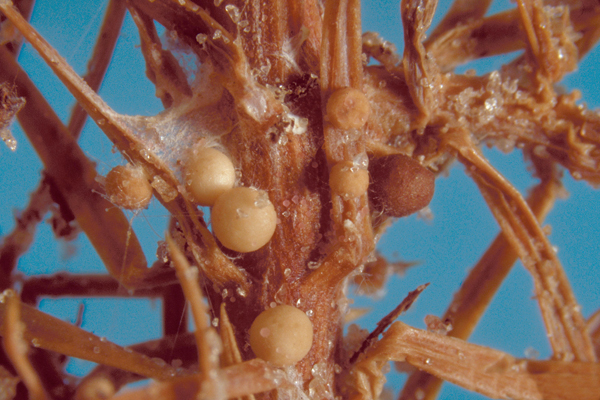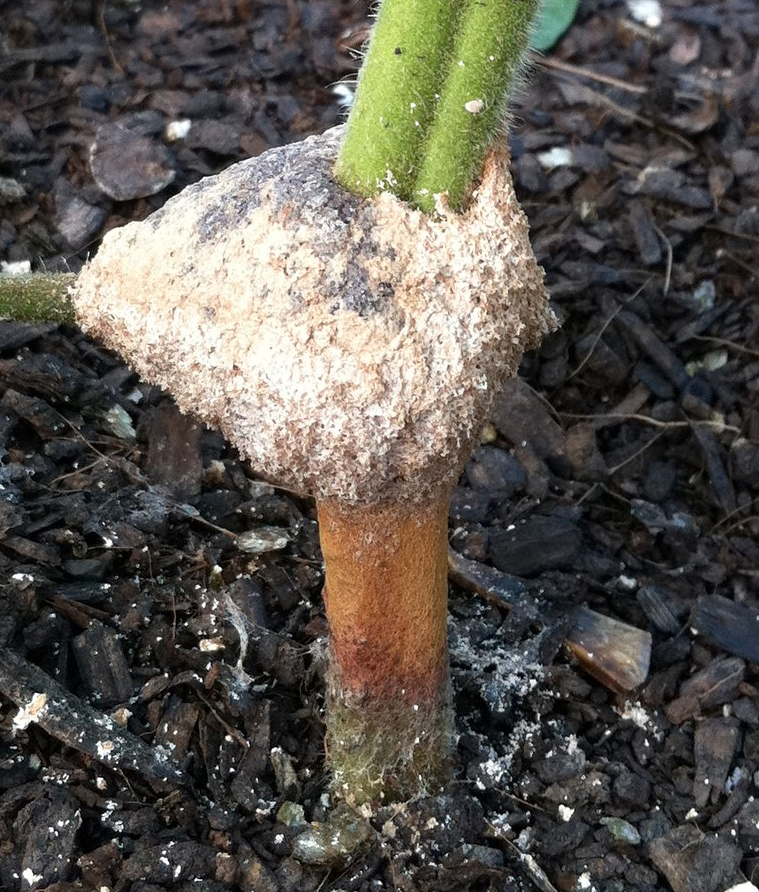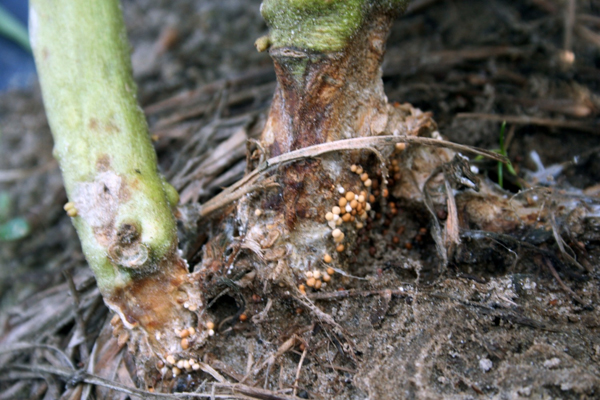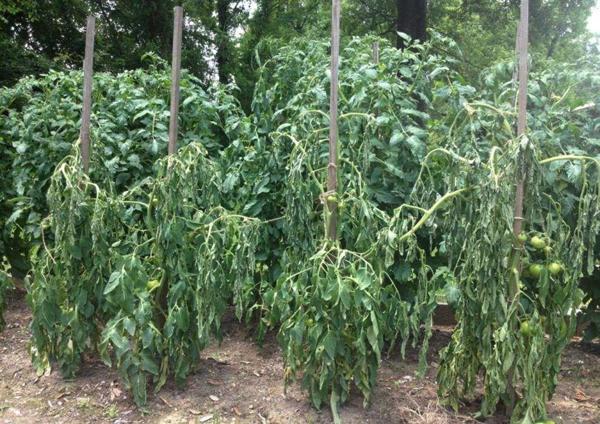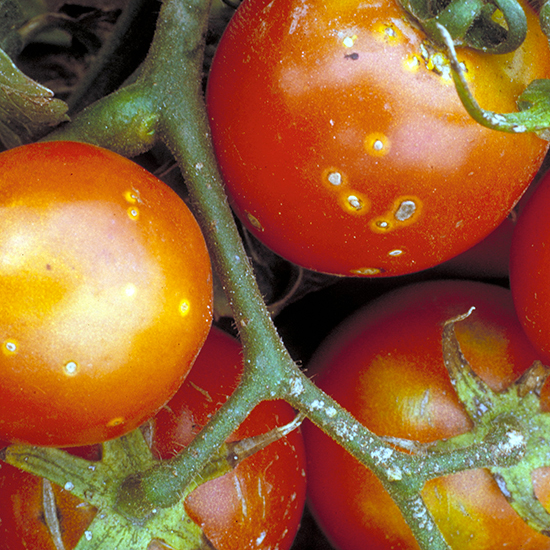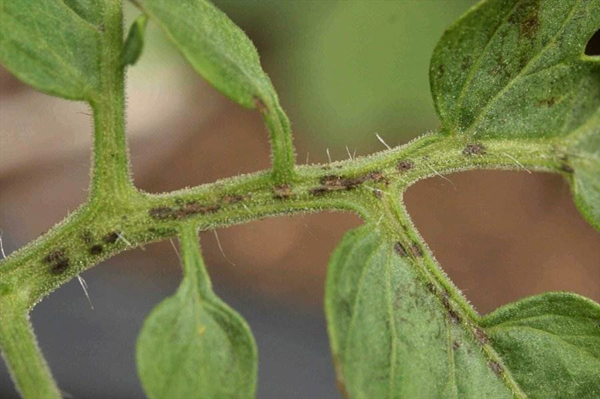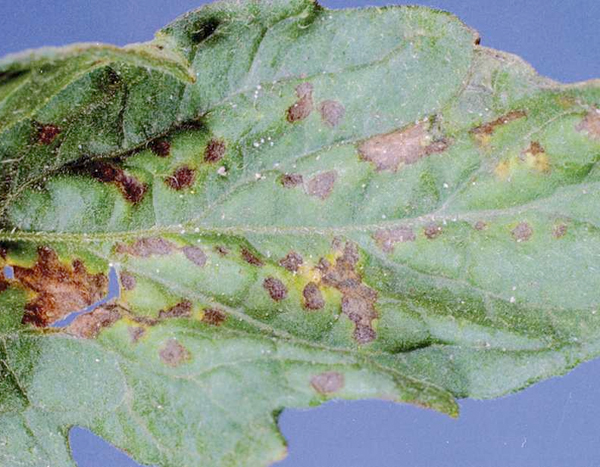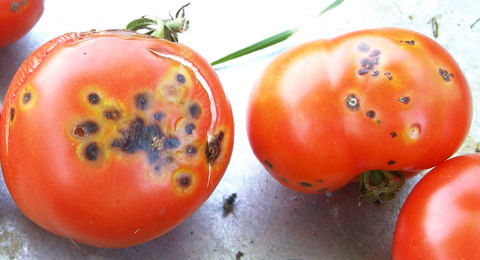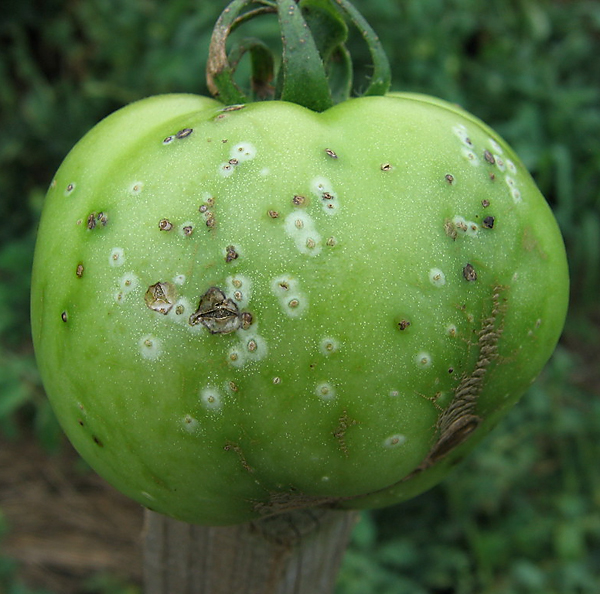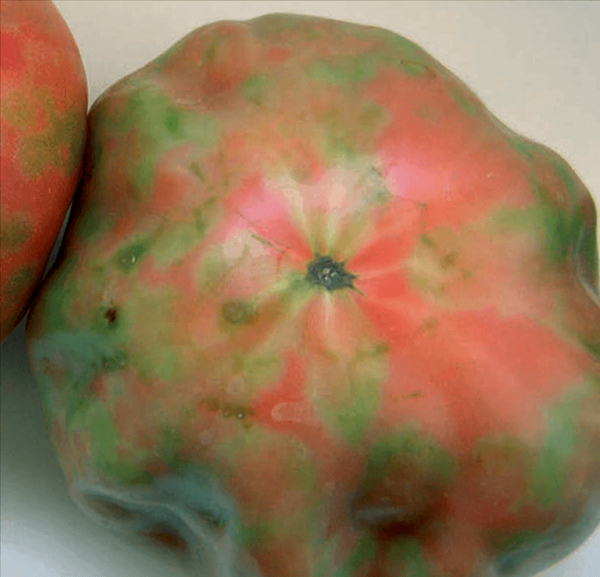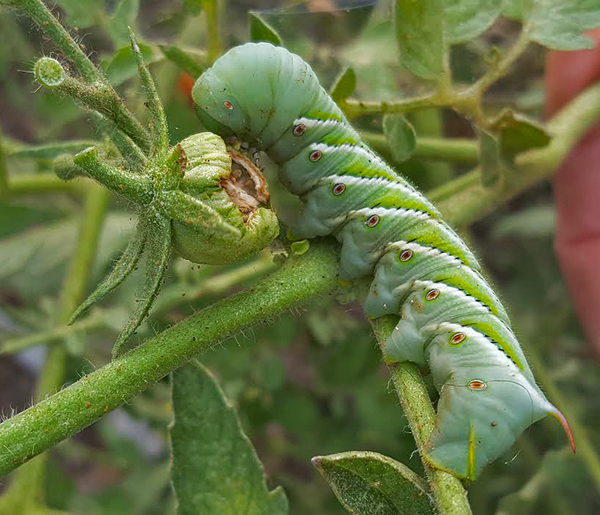
Chapter 21
Tomato Diseases and Physiological Disorders
Many good books have been written about tomato diseases and their treatment. It is not the intent of this book to deal with tomato problems and diseases in any great detail. We lightly touch upon some of the more common problems while keeping in mind that prevention is always easier than treatment.
Disease prevention cannot be overemphasized. With good growing habits, many diseases and problems can be prevented. As you read this chapter, you will see that it is important to remove all tomato leaves that are close to or touching the ground. Mulching prevents soil splatter onto these lower leaves, reducing the incidence of disease. Avoidance of overhead watering, or watering at a time when the leaves do not get a chance to dry before nightfall, is important in the prevention of fungal diseases. The sterilization of pruning equipment prevents disease spread. The removal of all crop debris and weeds at the end of the growing season has great value in disease prevention as does crop rotation and the use of disease resistant tomato varieties. If necessary, there are many insecticides and anti-fungal agents available for use, but most of these should be held in reserve until needed – though at times they may be used as a preventive measure. Watch your plants closely, and don't overuse chemical pesticides.
Grower Comments on Tomato Problems
"I grow strictly organic. I like to use powdered milk as a preventative – one package to 2 gallons of water. I spray the plants and also root feed. This provides valuable calcium, and the plants love it. However, if I'm really plagued, and nothing else helps, I will resort to Daconil." Minnie Z.
The next few pages are broken down into fungal diseases, bacterial diseases, viral diseases, and other diseases and physiological disorders.
Fungal Diseases

Early Blight is caused by the fungus, Alternaria solani. Leaf infection is notable first on older leaves with the appearance of irregular brown necrotic lesions surrounded by an area of yellowing tissue. If high temperature and humidity occur at this time, much of the foliage is killed. Lesions on the stems are similar to those on leaves, sometimes girdling the plant if they occur near the soil line (collar rot). On the fruits, lesions attain considerable size, usually involving nearly the entire fruit and appear as concentric rings. Heavy dews and overhead irrigation can contribute to disease spread. The fungus survives on infected debris in the soil, on seed, and on volunteer tomato plants. Use resistant or tolerant varieties and pathogen-free seed, clean your garden, and avoid overhead watering.
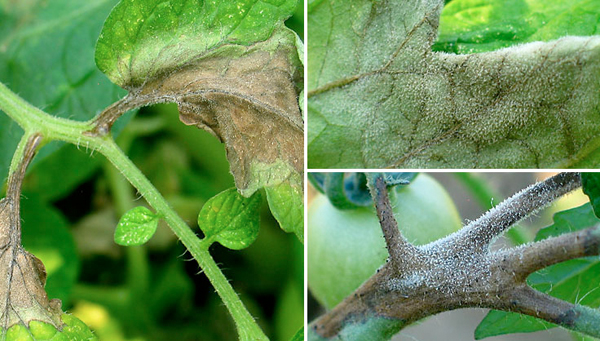
Late Blight is a potentially serious disease caused by the fungus, Phytophthora infestans. Young leaf lesions are small and appear as dark, water-soaked spots. These leaf spots will quickly enlarge and a white mold will appear at the margins of the affected area on the lower surface of leaves. Complete defoliation (browning and shriveling of leaves and stems) can occur within 14 days from the first symptoms. Infected tomato fruit develop shiny, dark, or olive-colored lesions, which may cover large areas. Fungal spores are spread between plants by rain and wind. A combination of warm daytime temperatures with high humidity is ideal for infection. Keep foliage dry and locate your garden where it will receive morning sun. Avoid overhead watering, especially late in the day. The fungus develops rapidly during periods of cool wet weather. Fungicide sprays as a preventative measure during these periods may be useful. Pull out and destroy diseased plants. If the infestation is severe enough to warrant chemical control use a fungicide and follow the instructions on the label.
Leaf Mold is a fungal infection caused by Cladosporium fulvum. It is first observed on older leaves near the soil where air movement is poor and humidity is high. Symptoms appear as light green patches on the upper surfaces of older leaves. Underneath the leaves in these areas, a purplish or olive-green patch of mold growth is visible. Infected leaves turn yellow and drop off the plant. Occasionally, the fungus attacks stems, blossoms, and fruits. Green and mature fruit can have a black, leathery rot on the stem end. The fungus survives on crop residue and in the soil. Spores are spread by rain, wind, or tools. Seeds also can be contaminated. The fungus is dependent on high relative humidity and high temperature for disease development. All crop residue should be removed. Staking and pruning of tomato plants to increase air circulation helps to control the disease. Avoid wetting leaves when watering. Use of a preventative fungicide program can control the disease.
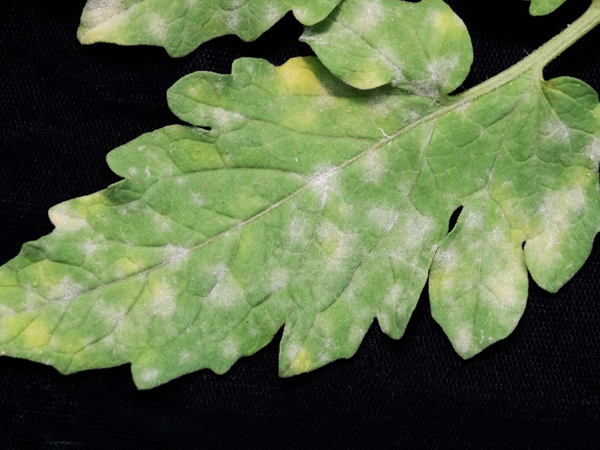
Powdery Mildew is a fungal disease caused by Blumeria graminis. Infected plants will display white powder-like spots on the leaves and stems. The lower leaves are the most affected, but the mildew can appear anywhere. As the disease progresses, the spots get larger and thicker as massive numbers of spores form, and the mildew spreads up and down the length of the plant. The leaves will eventually die, but usually remain attached to the stem. The disease is worse under warm, dry conditions. Sulfur dusts or wettable sulfur sprays are effective. Treatment may require the use of fungicidal agents. Prevention is a definite consideration using either a milk spray or a fungicide.

Buckeye Rot is a disease of the fruit caused by the fungus Phytophthora parasitica. The first fruit symptoms appear as brownish spots, often at the point of contact between the fruit and the soil. As the spots enlarge, dark, concentric rings can be seen. Under moist conditions, a white, cottony fungal growth appears on the buckeye rot lesions. With time, the entire fruit will rot. The fungus does not affect the foliage. The disease is most common during periods of prolonged warm, wet weather, and in poorly drained soils. The fungus survives in the soil and is spread by surface water and rain. Crop rotation, garden sanitation, staking, and mulching will help reduce the disease. Fungicides will control buckeye rot.
Septoria Leaf Spot is a destructive disease of tomato foliage (fruit are rarely infected) and is caused by the fungus Septoria lycopersici. Infection usually occurs on the lower leaves near the ground. Numerous, small, water-soaked spots with dark borders surrounding a light gray center appear on the older leaves. Black specks, which are spore-producing bodies, can be seen in the center of the spots. Severely spotted leaves turn yellow, die, and fall off the plant. Defoliation weakens the plant, reduces the size and quality of the fruit, and exposes the fruit to sunscald. The fungus can overwinter on crop residue. Repeated fungicide applications will keep the disease in check.

Fusarium Crown Rot is a fungal disease which can be caused by several members of the Fusarium genus. Infected plants are stunted and yellow. Symptoms begin on older leaves and progress to the entire plant which eventually turns brown and dies. The roots are brown and may rot away due to secondary pathogens. The stems often have brown vascular streaks, and dark brown lesions often occur on the stem near the soil line. Infection enters the plant through wounds, but it may also be seed born. Disease development is faster in cool wet soils.
Anthracose, sometimes known as canker, is a fungal disease caused by a wide variety of fungi. Infection enters the plant through wounds but may also be seed born. Disease development is faster in cool wet soils. Anthracnose is a common fruit disorder affecting primarily ripe fruits. Lesions appear first as sunken, circular spots that deepen and become dark in the middle. The lesion often takes on a "bullseye" appearance due to the concentric ring effect of the enlarging lesion. Water splashed on the fruit during rains or irrigation carry the fungal spores to the fruit. Control is by fungicide sprays.
Fusarium Wilt is a warm-weather disease caused by the fungus Fusarium oxysporum. The first indication of disease in small plants is a drooping and wilting of the lower leaves with a loss of green color followed by wilting and death of the plant. Older leaves wilt and curve downward and may turn yellow. The stem of wilted plants shows no soft decay, but when cut lengthwise, the woody part shows a dark brown discoloration of the water-conducting vessels. The fungus is soil borne and passes upward from the roots into the water-conducting system of the stem. Blocking of the water-conducting vessels is the main reason for wilting. Invasion occurs through wounds in roots growing through infested soil. The wilt becomes more extensive from day to day until the plant collapses and dies. Control can be obtained by raising the soil pH to 6.5 to 7.0 and using nitrate nitrogen rather than ammoniacal nitrogen. No chemical control is available. The fungus survives in soil for several years. Destroy infected transplants and stakes. Sanitize tools.
Southern Blight is a fungal disease caused by Sclerotium rolfsii. The first symptom is drooping of the leaves. On the stems, a brown, dry rot develops near the soil line. White mold growth with brown cabbage seed-sized brown structures may be visible on the outside of the stem near the soil line. The stem lesion develops rapidly, girdling the stem and resulting in a sudden and permanent wilt of all above ground parts. The fungus girdles the stem, cutting off water and nutrients. The fungus can also attack fruits where they touch the soil. It can survive for years in soil and plant debris. Crop rotation and removal of plant debris immediately after harvest will help to control the disease. Deep turning of the soil, high calcium levels, and the use of ammonium-type fertilizers may help to deter the disease.

Gray Leaf Spot is a fungal disease caused by Stemphylium solani. Small brownish-black specks first appear on the undersides of leaves. These later develop into larger necrotic areas, and the tissue often falls out, leaving a shot hole type appearance. Spots may be surrounded by a yellow halo. Yellowing, leaf drop, and defoliation may occur in severe cases. The fungus can survive from year to year on weeds, so weed control is important. Leaf moisture from rain or dew increases disease severity. Fungicides are effective in control and prevention.
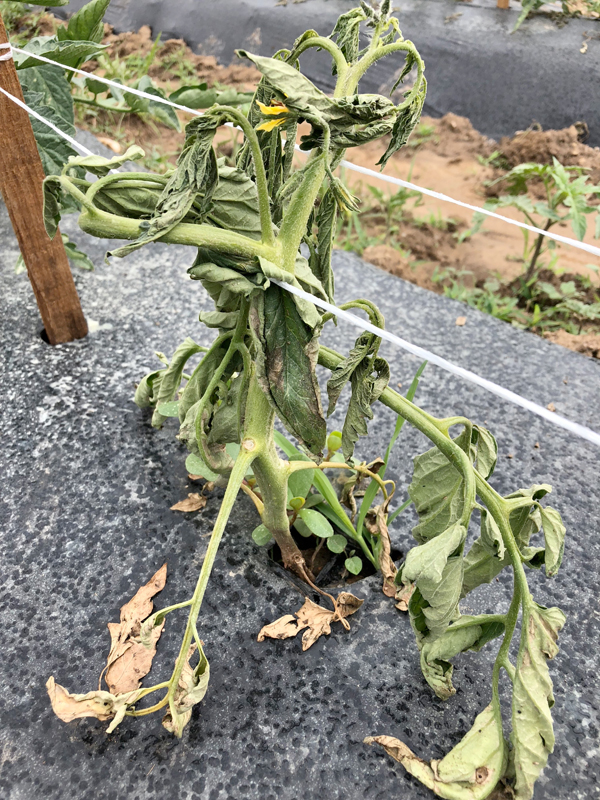
Phytophthora Root Rot is caused by Phytophthora parasitica and Phytophthora capsici. Brown sunken lesions develop on the stems near the soil line and will eventually girdle the plant resulting in wilting and rapid death. If the stem and tap root are cut lengthwise, a brown discoloration in the vascular tissue is evident. Water-logged or compacted soils promote this disease. The best control is careful attention to seedbed preparation. Avoid compaction and low spots that may accumulate water.
Verticillium Wilt is caused by Verticillium dahliae and Verticillium alboatrum. Older leaves on verticillium, wilt-infected plants begin wilting at the leaf margins and turn yellow, then brown. Plants are stunted and the wilting is not alleviated by watering. A light tan discoloration of the stem can be seen in cross section.

Seedling Disease (Damping-Off) is caused by the fungi Pythium and Rhizoctonia. Seedlings fail to emerge or small seedlings wilt and die soon after emergence or transplanting. Surviving plants have water soaked areas on the stem close to the soil line. Damping-off is often a problem in plants that are planted too early in the spring. The fungi are more active in cool, wet, rich soils. To prevent damping-off, start seeds indoors in a sterilized potting mix. Do not start seeds in soil that has a high nitrogen level. Add nitrogen fertilizer only after the seedlings have produced their first true leaves. Allow the surface of the soil to dry between waterings.
Bacterial Diseases
Bacterial Wilt is a serious disease caused by Ralstonia solanacearum. The bacteria survive in the soil for extended periods and enter the roots through wounds made by transplanting, cultivation, or insects, and through natural wounds where secondary roots emerge. The bacteria multiply rapidly inside the water-conducting tissue of the plant, filling it with slime. This results in a rapid wilt of the plant, while the leaves stay green. Control of bacterial wilt is difficult. Remove and destroy any plant that develops this problem. Rotation with corn, beans, and cabbage, which are not susceptible to Bacteria Wilt, for at least three years provides some control. Chemical control is not available against this disease, so it is best to use tomato varieties that are resistant .
Bacterial Spot is a bacterial disease caused by the bacterium, Xanthomonas vesicatoria, and attacks only green tomatoes. The disease is more prevalent during wet seasons. Damage to the plant includes leaf and fruit spots, which result in reduced yields, defoliation, and sun-scalded fruit. Dark brown water soaked spots appear on the leaves and later these spots become blackish, and eventually the affected tissue drops out leaving a hole in the leaf. Black, raised specks that later become scab-like spots appear at the same time on fruit. The bacteria survive the winter on infected plant debris. Moist weather and splattering rains are conducive to disease development. Most outbreaks of the disease can be traced back to heavy rainstorms. Infection of leaves occurs through natural openings. Infection of fruits occurs through insect punctures or other mechanical injury. Bacterial spot is difficult to control once it appears. Any water movement from one leaf or plant to another, such as splashing rain drops, overhead irrigation, and touching or handling wet plants, may spread the bacteria from diseased to healthy plants. Avoid overhead watering by using drip or furrow irrigation. Remove all diseased plant material. Prune plants to promote air circulation. Crop rotations are important. Copper sprays provide some control. Good sanitation practices and weed control help prevent the disease.
Bacterial Speck is widely distributed and is caused by Pseudoman syringae. Symptoms may appear on any plant part. Leaves of infected plants are covered by small, dark brown, irregular patches of necrotic tissue that are surrounded by yellow halos. Disease severity is increased by leaf wetness from sprinkler irrigation, rain, or heavy dews. Minimize wetting of the leaves by using drip or furrow irrigation. Copper sprays provide effective control.
Bacterial Canker is characterized by wilting and eventual death of the lower leaves, with the leaves drying up while still attached to the stem. Vascular tissue is discolored, brown, or brownish-yellow, and a characteristic yellow slime can be squeezed from affected stems. The bacterium that causes this disorder may be seed or soil born. Crop rotations and careful seed source selection are primary considerations. Seed beds in infected areas should be sterilized. Mechanical damage to the transplants spreads the disease.
Viral Diseases
Different viruses cause different symptoms in tomatoes. The symptoms of virus infection may appear as light and dark green mottling of the leaves. or the leaves may appear stunted, bronzed, or spotted, or they may have prominent purple veins. Fruits may have yellow spots. Tobacco mosaic virus causes mottling of older leaves and may cause malformation of leaflets, which may become shoestring-like in shape. Viruses are highly infectious and readily transmitted by any means that introduces even a minute amount of sap from infected plants into healthy plants. There are no chemical controls for viruses. Infected plants should be destroyed promptly. Wash your hands thoroughly before and after working in the garden. Eliminate perennial weeds near the garden. Control insects (thrips and whiteflies) that may carry viruses.
Tomato Mosaic Virus infected plants have a green/yellow mottled appearance and are usually stunted. Infected fruit may have necrotic brown patches on them. The virus is most commonly transmitted by handling or mechanical damage. Workers who smoke may infect plants with virus particles left on their hands after handling cigarettes. A variety of insects can also transmit the disease from infected weeds. All pruning equipment should be steam sterilized regularly to avoid disease transmission. Remove all garden debris at the end of the growing season. Rotate crops.
Other Diseases
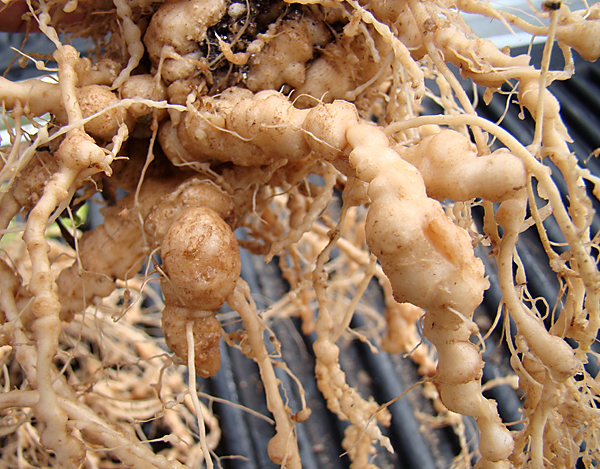
Root-knot is caused by nematodes, which are microscopic worms that live in the soil and in plant roots. Affected plants are usually stunted, discolored, and may die. The decline becomes rapid as the fruit load increases. The roots are swollen and covered with knots of galls. When root-knot nematodes are present it will be necessary to relocate your garden to a nematode-free area. Use nematode resistant tomato varieties which reduce root-knot nematode populations in soils. Soil solarization can also help reduce populations of nematodes in the garden. The root knot nematode is very difficult to control. Crop rotation with a non-susceptible species is important as a primary control. Many tomato varieties are resistant, so variety selection is also important.
Insects

Aphids, also known as greenfly or plant lice, are small, green-to-black, soft-bodied, winged or wingless insects that may be found in clusters on the undersides of leaves or on stems. They suck sap from plants causing the leaves to become discolored and distorted with a tendency to curl. Aphids can transmit diseases including both viruses and fungi. During one portion of their life cycle, they develop wings and fly from one plant to another. Aphids can be controlled with insecticides. Ladybug beetles also reduce their population.
Flea Beetle is a generic name applied to many species of small, up to 1/5 inch in length, jumping beetles commonly seen early in the gardening season. All flea beetle life stages are completed underground. Only the adults are commonly seen by gardeners. They have enlarged hind legs and can jump vigorously when disturbed. They chew small holes into and through the leaves so that they look as though they have been peppered with fine shot. Plants may be so badly eaten that they die. Flea Beetles also can transmit both fungal and viral diseases. They are difficult to control since they tend not to eat foliage that has been treated in any way.


Stink Bugs are shield-shaped, brown, green, or black insects that may be up to 1/3 inch wide and 5/8 inches long. They discharge a foul odor when squashed, thus the name. Adults and nymphs suck sap from the tomatoes and plants. The plants are weakened and the tomatoes may be deformed. Yellow-white spots appear under the skin of the ripe tomato. Prevention is by control of weeds in the garden. Insecticides are effective.

Blister Beetles are slender gray, black, or striped beetles 1/2 to 3/4 inches long that eat the leaves of tomato plants. Usually they appear in the garden late in the season. Deep tilling tends to prevent them. They may be hand picked, and insectides are effective against them.
Hornworms – The larval stage of this insect is a 3 to 4 inches long pale green caterpillar with 5 pairs of prolegs with a "horn" on the last segment. The tomato hornworm has "V" shaped markings with a horn that is often black. It feeds on the leaves and stems, leaving behind dark green or black droppings. Though initially quite small with a body about the same size as its horn, these insects pass through 4 or 5 larval stages to reach full size in about a month. The coloration of larvae cause it to blend in with its surroundings, and is often difficult to see despite its large size. It eventually will burrow into the soil to pupate. There are two generations a year. This insect is parasitized by a number of insects. One of the most common is a small Braconid wasp. Larva that hatch from wasp eggs laid on the hornworm, feed on the inside of the hornworm until the wasp is ready to pupate. The cocoons appear as white projections protruding from the hornworms body. If such projections are seen, leave the infected hornworms in the garden. The wasps will kill the hornworms when they emerge from the cocoons and will seek out other hornworms to parasitize. Handpicking is an effective control in small gardens. Bt (Bacillus thuragensis) and other insecticides may also be used to control hornworms.
Tomato Fruitworms are green, brown, or pink with light stripes along the sides and on the back. They are up to 1 inch long and are the larvae of various moths. The moths lay their eggs near the stem of the immature fruit, hatch after a week; then the larvae bore their way into the fruit where they feed. Cleaning all plant residue from the garden at the end of the season, and tilling, help as a preventative measure. Insecticides are effective.
Physiological Disorders

Blossom End Rot is a physiological disorder which can affect fruit at all stages of development. The characteristic symptom is a progressive deterioration of the blossom end of the fruit. Initially, water soaked spots are seen which enlarge and then become black. While secondary fungal infections may occur, blossom end rot is a physiological disorder caused by calcium deficiency induced by water stress. Careful water management practices are key. Irrigation and/or mulching are important. Application of lime or calcium prior to planting may help. Liquid fertilization using calcium nitrate can be used for small plots. The cause of this disorder is a calcium deficiency in the developing fruit. Extreme fluctuations in moisture, root pruning, and excessive nitrogen feeding can also enhance blossom end rot. Maintain a uniform supply of moisture through irrigation and soil mulches. Soil should be limed according to recommendations of a soil analysis report. Using gypsum (1 to 2 pounds per 100 square feet) as a supplement to liming on calcium-deficient soils has proven beneficial. Lime and/or gypsum should be applied before planting. After tomatoes are planted, spray the foliage with calcium chloride or calcium nitrate when symptoms first appear.

Sunscald occurs when tomatoes are exposed to the direct rays of the sun during hot weather. It is most common on green fruit. Decay causing fungi frequently invade the damaged tissue. The problem can be prevented by covering exposed fruit. Initially the fruit will develop yellowish or whitish patches on surfaces exposed to sunlight. These patches turn leathery then dry out. They may become infected with various types of mold as secondary infections enter the wounded tissue. Fruit protected by shade from leaf cover or shading material are unaffected. On a small scale, a grower can cover the tomatoes with straw or shade the plants with row cover. Minimizing pruning to leave a good cover of foliage will also prevent sunscald.
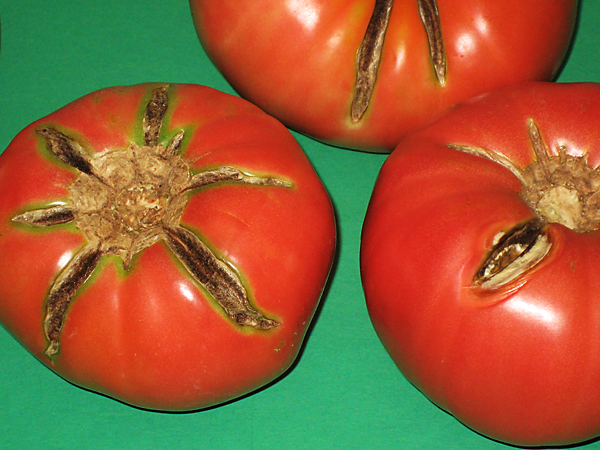
Growth Cracks are the result of water content fluctuations in the soil. Tomatoes crack when environmental conditions (drought followed by heavy rain or watering) encourage rapid growth during ripening. The tomatoes develop large cracks radiating out from the stem scar. The cracks may appear weathered and corky. Prevent wide swings in moisture by even irrigation or mulching. Tomatoes exposed to the sun develop more cracks than those protected by foliage. Avoid heavy pruning of plants. Concentric cracks are the splitting of the skin in a circular pattern around the stem scar. Radial cracks also occur and radiate toward the blossom end from the stem scar on mature green or red fruit. Insects and disease can attack damaged fruit. Some cracks may be deep, allowing organisms to enter the fruit, causing fruit rot. Radial cracking occurs on ripening fruit shortly after a heavy rainfall. The problem can be controlled by proper water management and pruning in concert with a good feeding program.

Cat-facing is a disorder caused by cold temperatures during fruit set. Cool and cloudy weather occurring at the time of bloom may cause the blossoms to stick to small fruit, resulting in malformation of the tomatoes as they develop. The tomato may be extremely malformed and scarred, usually at the blossom end. Tomatoes that develop later in the season will not be affected. To prevent the problem, protect young plants and early fruit from cold injury.

Leaf Roll is an upward curling of the leaves due to environmental stress. It is usually seen during periods of cool, rainy weather or following severe pruning. The lower leaves are the first to roll, but then it may continue up the plant. The leaves become thick and leathery. Leaf roll can be alleviated by reducing tomato stress during periods of high temperatures or drought conditions. No direct treatment is necessary as leaf curl does not kill the plant nor does it affect tomato yield. The best control is to maintain uniform soil moisture by using mulch and watering regularly.



